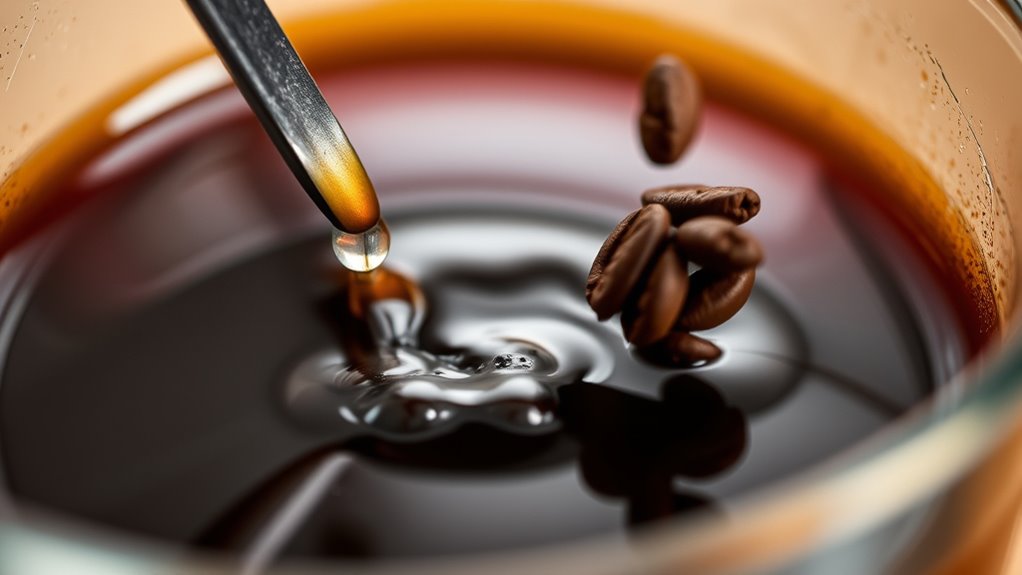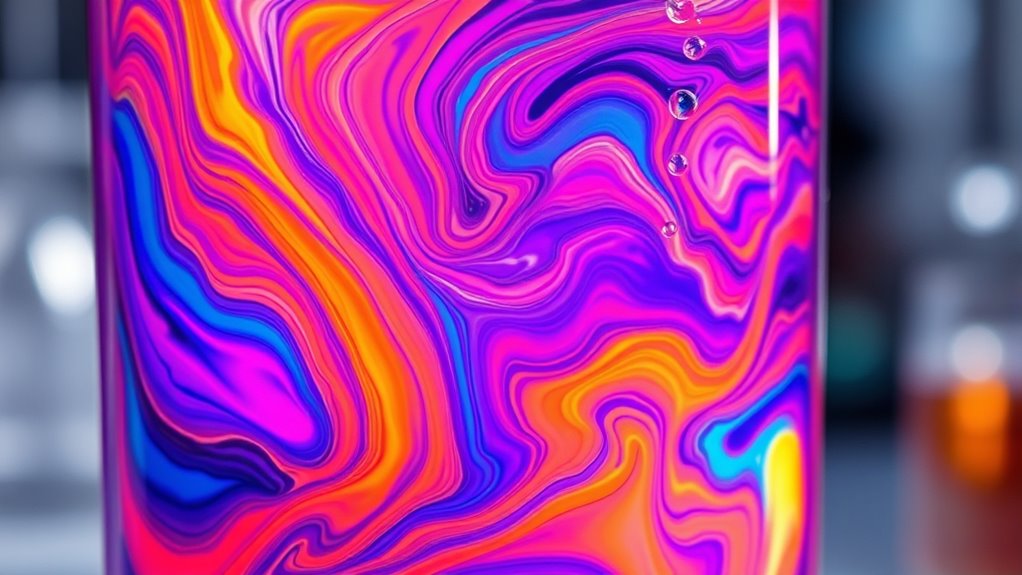To experiment with flavor using pre-infusion and agitation, start by evenly wetting your grounds or leaves and pause briefly to let gases escape. Gently stirring or swirling can help promote uniform extraction and prevent dull or bitter flavors. Adjust brewing time and temperature carefully to avoid over- or under-extraction. Small tweaks in these techniques can make a big difference, and if you keep exploring, you’ll discover the perfect balance for vibrant, flavorful brews.
Key Takeaways
- Pre-infusion evenly wets grounds/leaves, promoting uniform extraction and more vibrant flavors.
- Gentle agitation during pre-infusion enhances water contact and prevents flat or dull tastes.
- Adjusting brew time and agitation controls extraction strength, influencing flavor balance and richness.
- Proper temperature management during pre-infusion maximizes aromatic release and smooth flavor development.
- Experimenting with variations in pre-infusion duration and agitation helps discover personalized, optimal flavor profiles.

Pre-infusion and agitation are critical steps in optimizing the extraction process when brewing coffee or tea. They allow you to unlock more flavors and achieve a well-balanced cup. When you start with pre-infusion, you’re essentially wetting the grounds or leaves evenly, which helps ensure the subsequent extraction is consistent. This initial step often involves a short pause before the main brew begins, giving the particles time to bloom and release gases. It’s during this stage that temperature control becomes vital. Maintaining the right temperature ensures that the water interacts optimally with the grounds or leaves, extracting the full spectrum of flavors without becoming bitter or under-extracted. Proper vacuums for cleaning coffee equipment can also help maintain optimal brewing conditions by removing residues that could affect flavor.
Pre-infusion ensures even wetting and temperature control for a balanced, flavorful brew.
Brew time plays a crucial role here. If you rush through pre-infusion or skip agitation, you risk uneven extraction, leading to a flat or overly bitter taste. Conversely, extending brew time too long can cause over-extraction, pulling out undesirable compounds. By carefully controlling the brew time and incorporating pre-infusion, you give the water enough contact time to extract the rich flavors while avoiding excess bitterness. Agitation, whether by stirring, swirling, or even gentle shaking, complements this process. It helps break up the grounds or leaves, ensuring water reaches all parts of the bed, promoting uniform extraction.
Temperature control during pre-infusion is equally important. Too hot, and you risk scalding the grounds or leaves, which can produce off-flavors. Too cool, and you won’t extract enough of the aromatic compounds, resulting in a weak brew. Essentially, temperature ensures that the extraction process proceeds smoothly, maximizing flavor release without pulling unwanted bitterness. When combined with precise brew time and effective agitation, temperature control makes a significant difference. It allows you to fine-tune each step, creating a brew that’s vibrant, balanced, and full of complexity.
Experimenting with different levels of agitation and adjusting brew time can help you discover what works best for your taste preferences. For example, a quick stir after pre-infusion can enhance extraction, but too vigorous or prolonged agitation might lead to over-extraction and bitterness. Monitoring your temperature and brew time closely ensures you don’t overdo it. The goal is to find that sweet spot where flavors are maximized and unwanted notes minimized. With practice, you’ll learn how small adjustments in pre-infusion, agitation, brew time, and temperature control can elevate your brewing process, giving you a consistently better cup every time.
Frequently Asked Questions
How Do Different Liquids Affect Infusion Results?
Different liquids impact infusion results based on their viscosity and temperature control. Thicker liquids, with higher viscosity, slow down flavor transfer, requiring longer infusion times. Thinner liquids, with lower viscosity, infuse faster but may need careful temperature control to prevent overheating or flavor degradation. You should adjust your process according to these properties, ensuring consistent results by managing temperature and infusion duration based on the liquid’s viscosity.
Can Agitation Change Flavor Profiles Significantly?
Agitation can indeed change flavor profiles markedly, like stirring a storm in your cup. It enhances aesthetic appeal and sharpens sensory perception by promoting even infusion and release of flavors. This movement breaks barriers, allowing more complex notes to emerge, enriching your taste experience. Just as a gentle breeze can transform a calm lake, agitation breathes new life into your infusion, creating layers of flavor that might otherwise stay hidden.
What Are Common Mistakes in Pre-Infusion Processes?
You often make mistakes in pre-infusion by not paying attention to timing, which can lead to under-extraction or over-extraction. Guarantee your equipment is properly calibrated to avoid inconsistent results. Rushing the process or skipping calibration steps can compromise flavor development. Always monitor pre-infusion timing closely and regularly calibrate your equipment for ideal extraction and flavor. Proper attention helps you achieve balanced, flavorful brews consistently.
How Long Should Each Infusion or Agitation Last?
You should aim for an infusion timing of about 30 seconds to 1 minute for most flavor experiments, ensuring the flavors develop without over-extracting. For agitation duration, keep it brief—around 10 to 15 seconds—so you don’t disrupt the process or introduce bitterness. Adjust these times based on taste, but generally, shorter infusion and agitation periods help preserve the desired balance and clarity of flavors.
Are There Health Risks Associated With Aggressive Agitation?
Aggressive agitation can pose health concerns, like inhaling dust or particles, or causing spills that lead to skin irritation. To stay safe, always follow safety precautions, such as wearing gloves and masks, working in well-ventilated areas, and handling materials carefully. If you’re unsure about the risks, consult safety guidelines or professionals to minimize potential hazards and protect your health during flavor experiments.
Conclusion
By experimenting with pre-infusion and agitation, you can unbolt bolder, more complex flavors in your coffee. Did you know that baristas who use agitation techniques report a 20% increase in flavor extraction? So, don’t be afraid to shake things up—literally. Small changes can make a big difference in your brew’s taste. Try these methods and enjoy a richer, more vibrant cup every time. Your palate will thank you!








